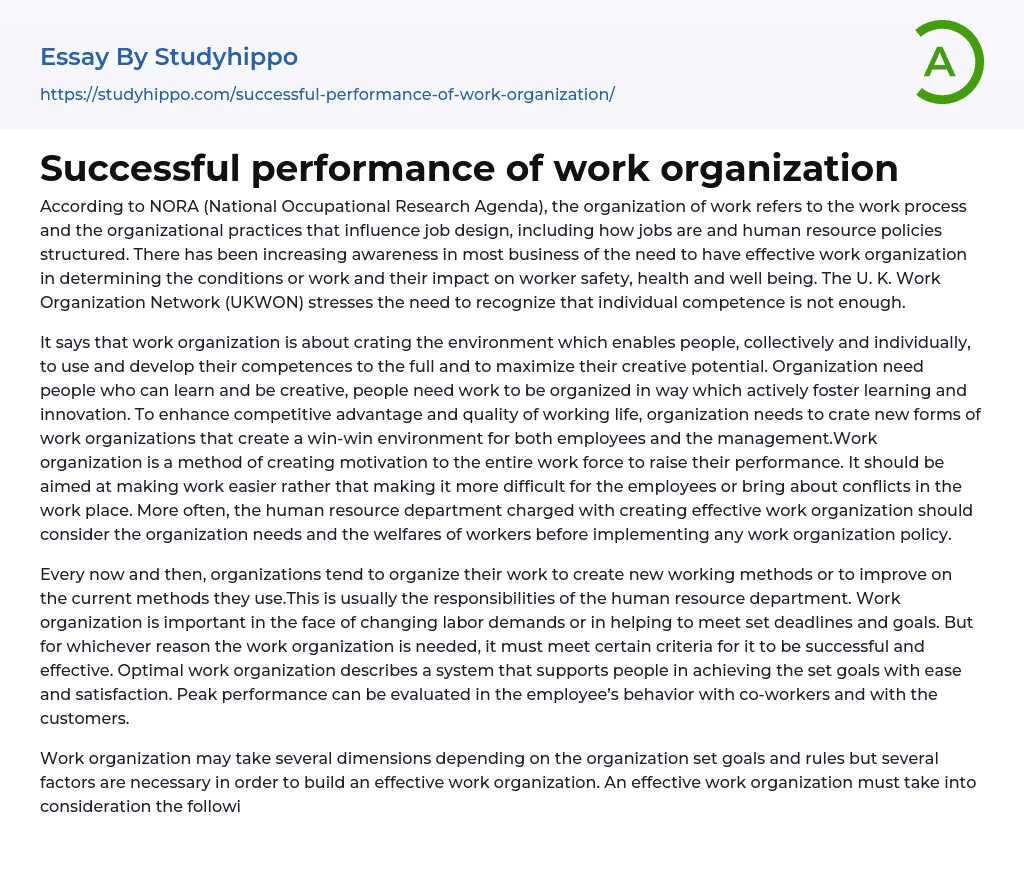

Successful performance of work organization Essay Example
NORA defines the organization of work as the work process and organizational practices that affect job design, encompassing job structure and human resource policies. More and more businesses are recognizing the importance of effective work organization in dictating work conditions and their impact on worker safety, health, and well-being. The UK Work Organization Network (UKWON) emphasizes the importance of acknowledging that individual competence alone is insufficient.
The message conveyed is that the process of work organization aims to establish a setting that promotes collective and individual use and development of competences, thereby maximizing creativity potential. As such, organizations require individuals who demonstrate a capacity for learning and innovation, while people require work arrangements that actively encourage these qualities. To optimize the quality of working life and competitiveness, organizations need to adopt work arrangements that foste
...r a mutually beneficial environment for employees and management alike. Work organization serves as a means of motivating the entire workforce to improve their performance, with the objective being to make work easier without inducing difficulty or conflict among employees. The human resources department tasked with effective work organization must prioritize organizational needs and employee welfare ahead of any policy implementation.
Occasionally, companies will restructure their processes or enhance current ones, an assignment usually given to the human resources department. It is vital to have proper work organization when dealing with changes in staff or deadlines and goals. To achieve successful and efficient work organization, specific standards must be met. The ultimate goal of work organization is to provide employees with a structure that enables them to accomplish their objectives easily and happily. Optimal performance can be identified by how well employee
interact with colleagues and clients.
Establishing an effective work organization involves considering multiple factors that are dependent on the objectives and regulations of the organization. However, certain fundamental aspects such as having a clear objective and implementing established standards for task completion within the new system must be taken into account.
To ensure successful policy implementation and alignment with the organization's mission, it is crucial to communicate clearly the objectives and deadlines. Additionally, the work organization should prioritize both organizational requirements and employee well-being by conducting a thorough evaluation of the intended benefits for both parties, which includes an effective cost-benefit analysis.
Ensuring employee welfare is the top priority for any organization's human resource department. To achieve this, extensive consultation with both staff and top-level management is necessary. Failure to consider all parties involved can result in work organization failure. Success hinges on executive management support at either a departmental or organizational level. However, relying solely on executives is inadequate as employees are responsible for policy implementation. Therefore, effective work organization necessitates careful cost-benefit analysis and thorough consultation with all relevant parties.
According to Susan M. Heathfield (2007), effective work organization necessitates a team-based approach, which can be challenging for any organization. The prevailing work culture often motivates individuals to prioritize their own objectives over those of the team, leading to ineffective teamwork and inadequate team building. Numerous organizations prioritize individual achievements through reward, recognition, and compensation systems.
According to her, typical systems for appraisal, performance management, promotions, and goal setting tend to prioritize individual goals and progress over team building. It's no surprise then that teams and teamwork often face difficulties in many organizations.
- Qualities essays
- American Dream essays
- Barriers To Entry essays
- Capitalism essays
- Central Bank essays
- Compensation essays
- Consumerism essays
- Economic Development essays
- Economic Growth essays
- Economic Inequality essays
- Economic System essays
- Economy essays
- Employment essays
- Export essays
- Finance essays
- Free Trade essays
- Gross Domestic Product essays
- Human Development essays
- Income Inequality essays
- Industry essays
- Inflation essays
- International Business essays
- International Trade essays
- Macroeconomics essays
- Materialism essays
- Max Weber essays
- Microeconomics essays
- Minimum Wage essays
- Monetary Policy essays
- Monopoly essays
- Pricing essays
- Profit essays
- Recession essays
- resources essays
- Taxation essays
- Trade essays
- Unemployment essays
- Warehouse essays
- World economy essays
- Code of Ethics essays
- Conflict essays
- Dress Code essays
- Human Resources essays
- Organizational Behavior essays
- Performance essays
- Recruitment essays
- Safety essays
- Accident essays
- Awareness essays
- Benefits of Volunteering essays



